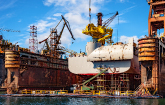The Silent Transition to Electric and Hybrid Vessels
The brand new IDTechEx report 'Electric and Hybrid Boats and Ships 2019 - 2029' expects investment to accelerate after 2020
BOSTON, Dec. 18, 2018 /PRNewswire/ -- Since the early 2010s, sales of pure electric and hybrid vessels have grown steadily, mainly driven by the need to reduce local pollution of NOx, SOx and particulate matter in a handful of emission control areas (ECA) that are local to coastlines. Vessel operators have chiefly turned to low-sulphur fuels such as LNG to comply, as well as invested in scrubbers to clean tail-pipe gases before they are released. However, many have invested in electric and hybrid powertrains, and the brand new IDTechEx Research report 'Electric and Hybrid Boats and Ships 2019 - 2029' expects this to accelerate after 2020 when now-confirmed global sulphur regulations are enforced by the International Maritime Organisation, as shown below.
Another strong driver, particularly for commercial vessels, is fuel economy. Many commercial vessels are installed with oversized engines in order to handle peaks in power demand. By adding batteries to handle transient loads, engines can be downsized and set to run consistently at high load -- where they were designed to run efficiently. Depending on the vessel type, the resultant fuel savings can reach 10 - 30 percent, translating to hundreds of thousands of dollars' worth of savings annually. For a $500,000 battery in a mid-sized vessel, short ROIs make the investment attractive.
One of the big challenges for electric and hybrid vessels is the pressure they put on the onshore local distribution network by drawing MW of current in short periods of time. One solution to this has been to install shore-side stationary storage to help handle the additional load, and to delay infrastructure upgrades. Shore-side solutions could even come in the form of second-life maritime batteries, which are already rugged and resistant to water ingress, as dismantling them to recycle the raw materials wastes the engineering. The first used batteries are likely to be returned in the early 2020s, a decade after the first hybrid vessels were christened.
By volume, electric recreational boating represents the largest and fastest transformation, with tens of thousands on the water today; by value the C&I segment is the largest due to the cost of multimillion-dollar vessels. Although a transition is underway, the new report finds ultimately there will be a coexistence with today's propulsion technologies because of upfront cost, range anxiety, lack of charging infrastructure and the slowness of change in the marine industry.
Based on a global assessment IDTechEx Research has developed forecasts by category and region for 2019 - 2029.
The key takeaways / benefits of the research in this report are:
- Insight into where electric vessels have grown rapidly and why.
- Current year market size and forecasts up to 2029 by recreational, commercial and industrial segments.
- Current year market size and forecasts up to 2029 by vessel type, including Recreational Boats, Ferry, Offshore Support Vessel, Tugboat, Fishing and Industrial.
- Overview of local and international regulation and policy driving the transition.
- Market share of leading maritime energy storage system suppliers.
- Market share of battery chemistry (NMC, LFP and others).
- List of 125 commercial and industrial projects tracked by IDTechEx (with detail on battery capacity and supplier).
For more information please contact [email protected] or visit www.IDTechEx.com/boats.
Media Contact:
Charlotte Martin
Marketing & Research Coordinator
[email protected]
+44(0)1223 810286
Related Links
Electric Vehicles: Everything is Changing USA 2018
SOURCE IDTechEx
Related Links
WANT YOUR COMPANY'S NEWS FEATURED ON PRNEWSWIRE.COM?
Newsrooms &
Influencers
Digital Media
Outlets
Journalists
Opted In






Share this article